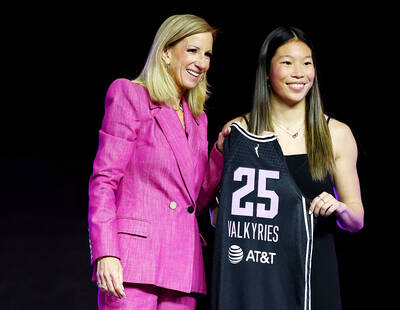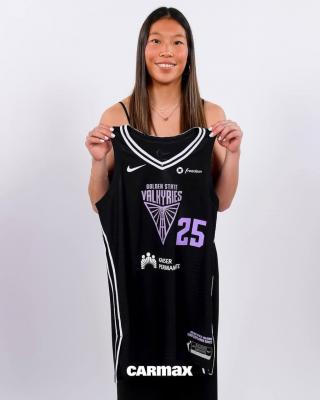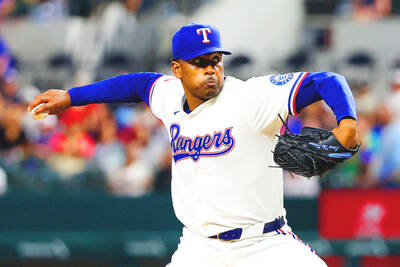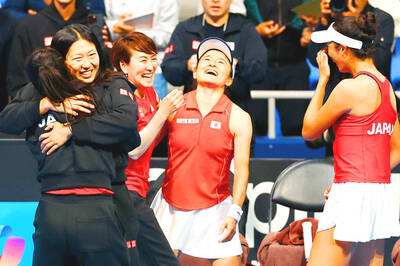Figuring out a cause for the skyrocketing number of arm injuries among pitchers is easy. Finding a solution could prove much more challenging.
The MLB issued a 62-page report in December last year that showed how the focus on throwing with increased velocity and using maximum effort on every pitch was a likely reason for the increase in injuries. The study provided numerical data backing a thesis already supported by conventional wisdom.
“It makes sense,” Cleveland Guardians right-hander Tanner Bibee said. “You do anything at a max capacity, you’re going to be at more risk for injury... It’s just kind of the nature of anything you do in life.”

Photo: AFP
The study showed that major league pitcher injured list placements increased from 212 in 2005 to 485 last year. Days on the list rose from 13,666 to 32,257.
Tommy John surgeries for major and minor league players increased from 104 in 2010 to a peak of 314 in 2020, although they slipped to 281 last year.
The study recommended “considering rule changes at the professional level that shift the incentives for clubs and pitchers to prioritize health and longevity.”
Instituting those types of rule changes could prove challenging when pitchers of all ages understand how much MLB organizations are emphasizing velocity.
“I don’t know if rules are the right way to go about it,” said Chicago Cubs left-hander Matthew Boyd, who underwent Tommy John surgery in 2023. “You can’t tell someone to throw softer, but I was a guy in college that threw high 80s. I would randomly throw a hard number, but I didn’t know how to do it consistently right, but I got outs. But I knew that some wise people ahead of me told me outs are going to get you to the big leagues, velocity’s going to get you drafted. So therein lies the problem.”
Perhaps most concerning were the statistics involving younger pitchers.
Prospects who threw 95mph (153kph) or faster at the Perfect Game National Showcase for top high-school players increased from three in 2018 to 36 last year. Thirty-five players selected in the top 10 rounds of last year’s amateur draft had Tommy John surgery, up from four in 2005.
The evidence of increasing injuries is not limited to the MLB’s study. An Orthopaedic Journal of Sports Medicine study showed there were five times as many injuries among Pac-12 baseball players in 2021 as in 2016, although that applied to all players and not just pitchers.
One school of thought suggests that any changes need to start at the youth level. That idea has the support of Eric Cressey, who trains more than 100 professional baseball players in Florida and Massachusetts.
He is also the New York Yankees’ director of player health and performance.
“I’ve long maintained that everything begins with fixing what’s happening at the younger levels, and there will eventually be a trickle-up to the big leagues,” Cressey said.
Young pitchers throwing max-effort showcases in the off-season and disregarding basic warm-up guidance has contributed to significant injuries, he said.
“Thirteen-year-olds should never be blowing out ligaments,” he said. “That should just not be happening, and every time it happens, it’s because someone made a terrible, terrible decision on that child’s behalf, whether it’s a coach or a parent ... some of the things that I see in the youth space are nothing short of embarrassing.”
Cressey recommended imposing a scouting dead period for the months of October, November and December.
“It’s absurd for us to ask a still immature 17-year-old to go out and throw 95mph in November when major league players are resting during that time period,” he said.
The pressure can start at the youth levels, which explains why the MLB has established Pitch Smart initiatives that set recommended workload limits for pitchers.
“What’s challenging right now is it’s hard to close Pandora’s box,” Cressey said. “A lot of these kids who are 25 and blowing out in the big leagues, they were kids who were doing a lot of things incorrectly in their teenage years, and now they’re just bigger, stronger and are in higher-pressure situations.”

College basketballer Kaitlyn Chen has become the first female player of Taiwanese descent to be drafted by a WNBA team, after the Golden State Valkyries selected her in the third and final round of the league’s draft on Monday. Chen, a point guard who played her first three seasons in college for Princeton University, transferred to the University of Connecticut (UConn) for her final season, which culminated in a national championship earlier this month. While at Princeton, Chen was named the Ivy League tournament’s most outstanding player three times from 2022 to last year. Prior to the draft, ESPN described Chen as

College basketballer Kaitlyn Chen (陳凱玲) has become the first player of Taiwanese descent to be drafted by a WNBA team, after being selected by the Golden State Valkyries in the third and final round of the league's draft yesterday. Chen, a point guard who played her first three seasons in college for Princeton University, transferred to the University of Connecticut (UConn) for her final season, which culminated in a national championship on April 6. While at Princeton, Chen was named the Ivy League tournament's most outstanding player three times from 2022 to last year. Prior to the draft, ESPN described Chen as a

Kumar Rocker, a first-round pick in both the 2021 and 2022 drafts, on Thursday won for the first time in the major leagues. Rocker struck out a career-best eight in a career-best seven innings as the Texas Rangers beat the Los Angeles Angels 5-3 to complete a three-game sweep. Rocker (1-2) threw a career-high 78 pitches and allowed three runs on five hits without a walk. The 25-year-old right-hander was drafted third overall by Texas in 2022, a year after concerns over a physical led to him going unsigned by the New York Mets as the 10th overall pick. He made his major

Japan yesterday secured a second consecutive Billie Jean King Cup finals appearance with a 2-1 win over 2023 champions Canada, thanks to Ena Shibahara and Shuko Aoyama’s 6-3, 5-7, 6-2 win over Kayla Cross and Rebecca Marino in the qualifying doubles decider. Shibahara and Aoyama powered through the opening set 6-3, breaking twice for a quick 3-0 lead. Cross and Marino hit back in the second, edging it 7-5 to level the match, before the Japanese pair regained control in the third. Canada’s 18-year-old Victoria Mboko edged Shibahara 6-4, 6-7 (8/10), 7-5 in a marathon opening clash. Mboko fired eight aces to